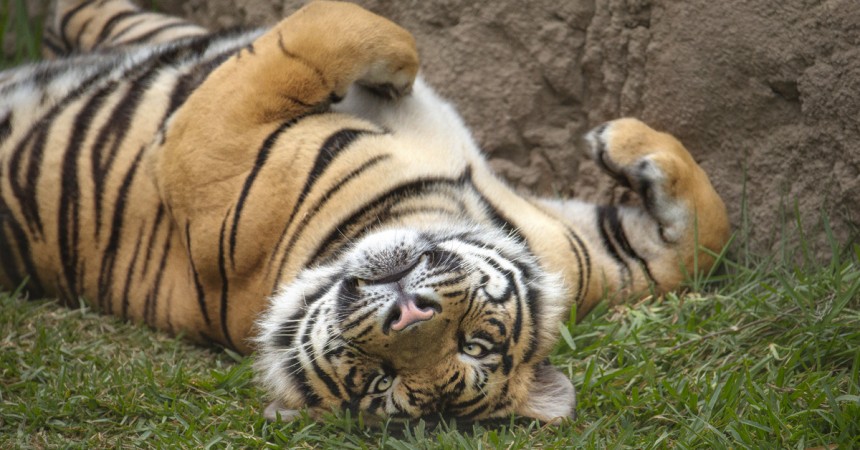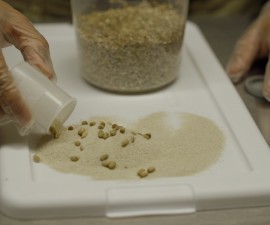Ever wonder what the day of a tiger care specialist is like? Here at the Safari Park, our day starts early—at 6 a.m.! When we arrive, our first order of business is to bring all of the cats that spent the night outside on exhibit into the eight bedrooms inside the tiger house.
People often think it might be difficult to convince them to come in from their beautiful and spacious exhibits, but the truth is, they usually come running. That’s because they know that once they’re inside, it’s time for breakfast! All of the cats get between 4.5 to 6 pounds of ground meat daily, and we typically like to divide their diet up into two to three feedings throughout the day. This allows us more opportunity to work with the cats, and it also helps to make their day a bit more interesting. We’ll often use their breakfast to work on some of their trained behaviors, or as a reward for simple desensitization, such as for blood draws, temperatures, or even just for sitting comfortably inside their transport crate. During that first meal of the day, we also take the opportunity to visually inspect them, and make sure all is well.

Sumatran tiger Thomas enjoys a refreshing dip in his private pool in the Safari Park’s new Tiger Trail habitat.
Once everyone is satiated, we head out to inspect the exhibits. First, we of course make sure they’re clean and safe for the cats, and then it’s time to add enrichment! Enrichment refers to anything we can incorporate into the tigers’ day to make their lives more fun, interesting, or challenging. On exhibit, that can involve anything from scattering some treats to encourage foraging behavior, to simply spraying various scents on logs, rocks, or substrates. Sometimes we’ll even use products from other animals, such as ocelot bedding, rhino dung, or hair that’s been shed by our camels. This way, their exhibits always offer them something new to explore.
When the exhibits are ready, it’s time to send some of the cats outside. As another way to keep things interesting, the cats are all rotated daily, between the three exhibits and the eight bedrooms inside. That way, no one is in the same place for two days in a row! The cats that stay inside for the day also have their bedrooms cleaned and well-stocked with enrichment, ranging from heavy-duty tiger toys, to scented paper bags or cardboard boxes. Coming up with novel ways to present these items is always very enriching for us as keepers too! As an animal care specialist, it’s a highlight to watch Delta rolling happily on her rosemary bedding, or one of the boys tackling their favorite “weebil” toy.
Once the rest of our work is done, it’s time for record keeping. Not only do our tigers have twelve different people taking care of them, but veterinarians, nutritionists, researchers, and reproductive physiologists also keep tabs on the cats. For that reason, keeping detailed notes is a very important part of our job. We have record books, training and enrichment logs, and daily reports that help everyone track and monitor necessary information. Throughout the day, we also do various training demonstrations with the tigers on exhibit. This allows our guests to view some of the cats’ husbandry behaviors and have a better understanding of how we interact with them, but it also provides our tigers with the best possible care.
Lori Hieber is senior keeper at the San Diego Zoo Safari Park.






